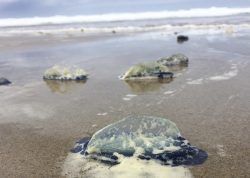
As their name suggests, by-the-wind sailor jellyfish know how to catch a breeze. Using a stiff, translucent sail propped an inch above the surface of the ocean, these teacup-sized organisms skim along the water dangling a fringe of delicate purple tentacles just below the surface to capture zooplankton and larval fish as they travel.
At the mercy of the wind, these jellies can wash ashore and strand — sometimes numbering in the trillions — on beaches around the world, including up and down the U.S. West Coast. And while these mass stranding events are hard to miss, very little actually is known about how or why they happen.
Now, thanks to 20 years of observations from thousands of citizen scientists, University of Washington researchers have discovered distinct patterns in the mass strandings of by-the-wind sailors, also called Velella velella. Specifically, large strandings happened simultaneously from the northwest tip of Washington south to the Mendocino coast in California, and in years when winters were warmer than usual. The results were published March 18 in the journal Marine Ecology Progress Series.
“Citizen scientists have collected the largest and longest dataset on mass strandings of this jelly in the world,” said senior author Julia Parrish, a professor in the UW School of Aquatic and Fishery Sciences and executive director of the Coastal Observation and Seabird Survey Team, known as COASST.
“This paper contributes to fundamental scientific knowledge of this organism in a way that traditional ‘mainstream’ marine science has been unable to do. Thousands of trained, dedicated observers are better than any satellite because they know their beach and can alert us if something is weird or unusual.”
Read more at UW News »
